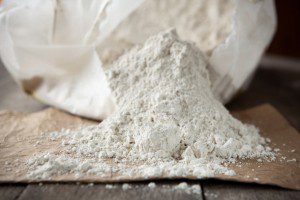Guest Writer for Wake Up World
Diatomaceous earth (also called diatomite) is an off-white sedimentary rock that has been granulated into a chalky powder-like substance akin to talcum powder.
It derives from fossilized remains of something called diatoms, which are a type of prehistoric tough-shelled, single-celled organisms similar to algae. These diatoms are ocean based and, over the span of 50 million years, came to be embedded into the Earth’s crust. The fossil shape of diatoms is uniquely characterized by the diatoms’ symmetrical or twin-shell structure.
Fun Fact: Diatomite was first discovered around 1837 in Northern Germany, and many interesting applications for the product began to be conceived. Alfred Nobel, the inspiration for the Nobel Prize, used the chemical properties of diatomaceous earth to invent dynamite.
Diatomaceous Earth: Basic Facts
[pro_ad_display_adzone id=”110028″]
Deposits of diatomite are found throughout diverse regions of the world, typically in lakes and marine areas. There are generally five common varieties of diatomite sourced throughout the world today: Tripolite (from Tripoli, Libya), Bann (from Lower Bann Valley, Ireland), Moller (from Denmark), freshwater lake regions, and saltwater.
Interestingly, each geographically-diverse deposit of diatomaceous earth has a different shape and structure due to the varying amounts and types of other minerals and clays in the surrounding earth composition. The silica content can vary within different deposits depending on age. There are even different species of diatomaceous earth which are also determined by the diatoms’ age and historic environment. The species ultimately determines the shape and structure.
What is Diatomaceous Earth?
There exist two forms of diatomite in use today: food-grade (unheated/unadulterated) and industrial grade (heated). Food-grade diatomaceous earth is naturally dried (termed ‘uncalcined’) and has different properties and structure than industrial-grade diatomite. The heating of the diatomaceous earth for industrial use changes the structure from amorphous (unstructured, free-flowing) characteristics to a crystallized, structured form (calcined).
The overwhelming majority of diatomaceous earth is used in industrial applications, such as:
- Insecticide and commercial pesticide
- Filtration medium in water systems, swimming pools, and food
- Mild abrasive use in hygiene products such as toothpaste and facial washes
- Absorbent use such as in toxic liquid spills, cat litter, and ethylene gas
- Preservative
- Use in DNA processing and purification
- Hydroponic garden growing medium
- Anti-caking agent in grain storage and livestock dewormer
Though the majority of diatomaceous applications are industrial in scope, an increasing area of interest for its use lie in human and animal applications, particularly for its exciting benefit as a safe and effective anti-parasitic. Data suggests that food-grade diatomaceous earth contains nutritive properties, owing its rich mineral content–silica, in particular–to skeletal health and metabolism support.
Up to one-third of diatomite’s natural silica content is rendered bioavailable for the nutritive trace mineral silicon, among other trace minerals including boron, manganese, and copper. Additionally, diatomite contains a rich electrolyte mineral content consisting of up to 19% calcium, 5% sodium, and 3% magnesium, depending on deposit variables.
Alternative Health Properties of Diatomaceous Earth
Food grade diatomaceous earth offers important benefits, particularly related to the fact that it is composed of approximately 85% amorphous silica. In the past, humans were able to consume enough silica in food, but as modern hybrid foods and toxic soil became a reality, studies suggest that only about 1/3 of the silica that we need is present in our fruits and vegetables. This is a sad fact, given that silica is such a necessary component for the health of our tendons, cartilage, blood vessels, and bones. It is also needed for the health and strength of our skin, teeth and nails. It even contributes to the health of almost all of our vital organs, including the heart, liver and lungs.
A strong abrasive, Diatomaceous Earth is composed of a unique combination of 33% silicon, 19% calcium, 5% sodium, 3% magnesium and 2% iron, as well fifteen other trace minerals like boron, manganese, titanium, copper and zirconium.
Silica is an important trace mineral for human beings, and one that many are unaware that they need. Dr. Barbara Hendel, author of “Water & Salt” has even stated that, “Silica is the most important trace mineral for human health.”
The oldest use of diatomaceous earth has been as a toothpaste and facial scrub, due to its mild abrasive capacities. Similarly, it acts as a mild abrasive in animals, removing intestinal invaders and other harmful organisms from the digestive tract, stimulating digestion and absorption of nutrients by sweeping foreign bodies out of the system. Diatomaceous Earth is also chocked-full of naturally occurring trace minerals. These minerals promote strong nails, healthy skin and shinier hair in animal use.
Other Heath Benefits of Diatomaceous Earth:
- Increases mineral absorption: As silica is water-soluble and does not remain in the body for very long, supplementing with diatomaceous earth aids the body in keeping optimal absorption of these important minerals.
- May aid in lowering cholesterol and blood pressure.
- May contribute to more regular bowel movements, as it acts as an internal cleansing aid.
- Used in livestock feed to control intestinal parasites, which are lacerated by the abrasiveness of diatomaceous earth. It has also shown great success in ridding animals of E.coli, as well as other forms of bacteria and viruses.
- Contains anti-fungal properties.
- Acts as a powerful overall detoxification agent — A strong natural bonding agent, diatomaceous earth sucks heavy metals (such as those contained in vaccines, drinking water and foods.
Other Interesting Info and Benefits of Diatomaceous Earth
Diatomaceous earth is often used as a natural insecticide, as its absorption properties actually dehydrate the waxy outer layer off of the insects’ exoskeleton, causing them to expire. Food and medical-grade diatomaceous earth is also used as a safe and non-toxic way to de-worm pets, and it has even been used as a natural form of cat litter. The U.S. Centers for Disease control recommends it as a natural method for neutralizing toxic spills. It is also a common ingredient in oil-absorbing natural facial products and masks.
Do you use diatomaceous earth? What do you use it for? Please let us know your experiences in the comments!
Dr. Edward F. Group III, DC, ND, DACBN, DCBCN, DABFM
Article references:
- Antonides, Lloyd E.. Diatomite. USGS.
- Mineral resources of Virginia By Thomas Leonard Watson, Ray Smith Bassler, Heinrich Ries, Roy Jay Holden, Virginia. Jamestown Exposition Commission. p.216-217.
- http://www.ghorganics.com/DiatomaceousEarth
- http://wolfcreekranch1.tripod.com/diatomaceous_human_use
- http://www.reade.com/Products/Minerals_and_Ores/diatomaceous_earth
- http://www.shirleys-wellness-cafe.com/saltresearch
Previous articles by Dr. Group:
- B-12: The Miracle Vitamin
- 7 Herbs for Men’s Health
- 6 Things You Must Know About Colloidal Silver
- The 9 Best Herbs for Lung Cleansing and Respiratory Support
- 7 Best Foods to Support Kidney Function
- How to Flush the Liver
- Lung Cleansing With Peppermint Oil
- The 5 Most Common Thyroid Disorders and What You Need To Know
- Nine Shocking Dangers of Fluoride Exposure
- Seven Facts You May Not Know About Coconut Oil
- 5 Dangerous Chemicals in Conventional Sunscreens
- 10 Best Herbs for Boosting Female Sex Drive
About the author:
 Dr. Edward F. Group III (DC, ND, DACBN, DCBCN, DABFM) founded Global Healing Center in 1998 and is currently the Chief Executive Officer. Heading up the research and development team, Dr. Group assumes a hands-on approach in producing new and advanced degenerative disease products and information.
Dr. Edward F. Group III (DC, ND, DACBN, DCBCN, DABFM) founded Global Healing Center in 1998 and is currently the Chief Executive Officer. Heading up the research and development team, Dr. Group assumes a hands-on approach in producing new and advanced degenerative disease products and information.
Dr. Group has studied natural healing methods for over 20 years and now teaches individuals and practitioners all around the world. He no longer sees patients but solely concentrates on spreading the word of health and wellness to the global community. Under his leadership, Global Healing Center, Inc. has earned recognition as one of the largest alternative, natural and organic health resources on the internet.
For more information, please visit Global Healing Center.
[pro_ad_display_adzone id=”110027″]







